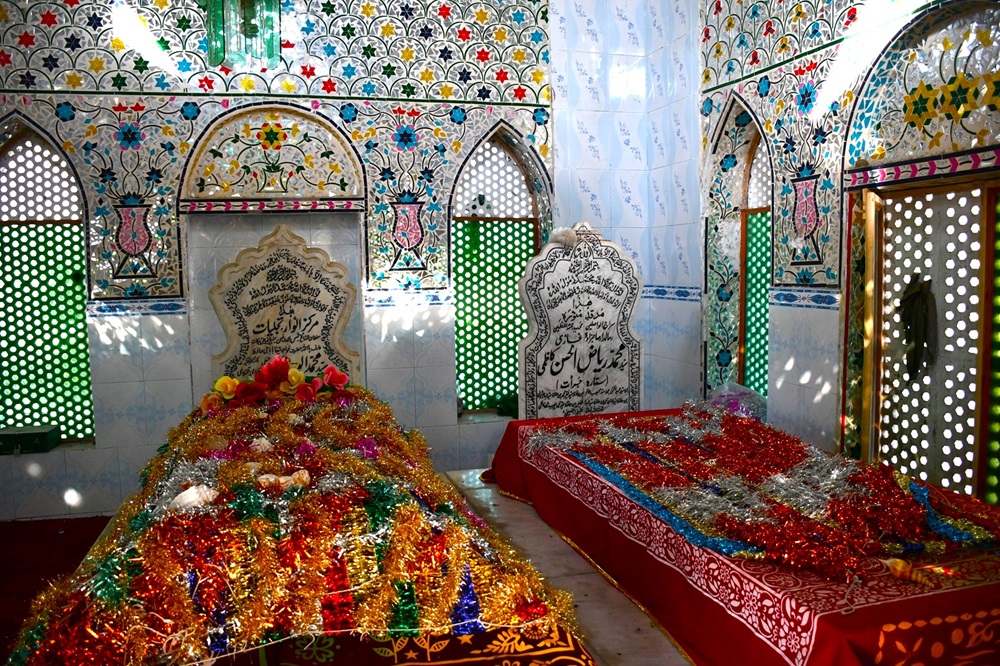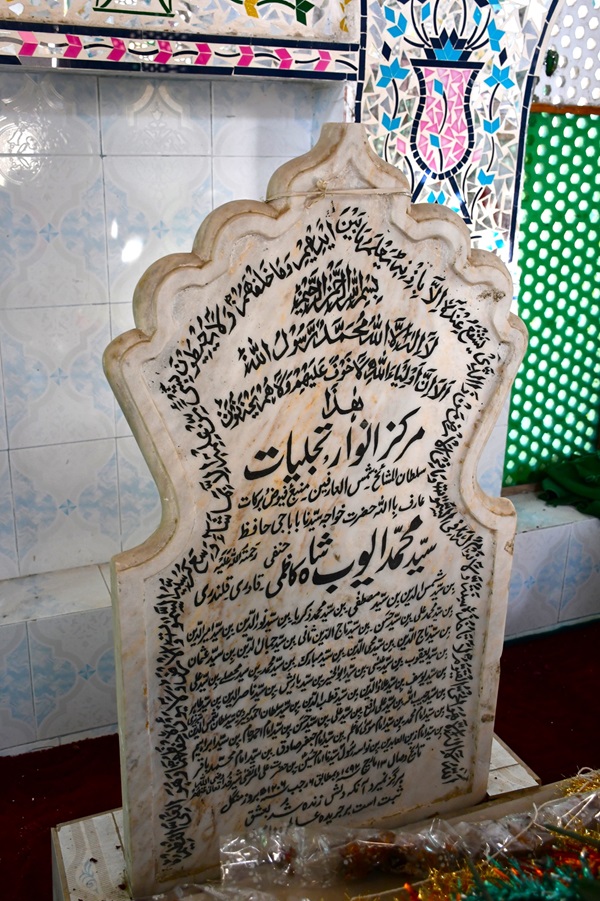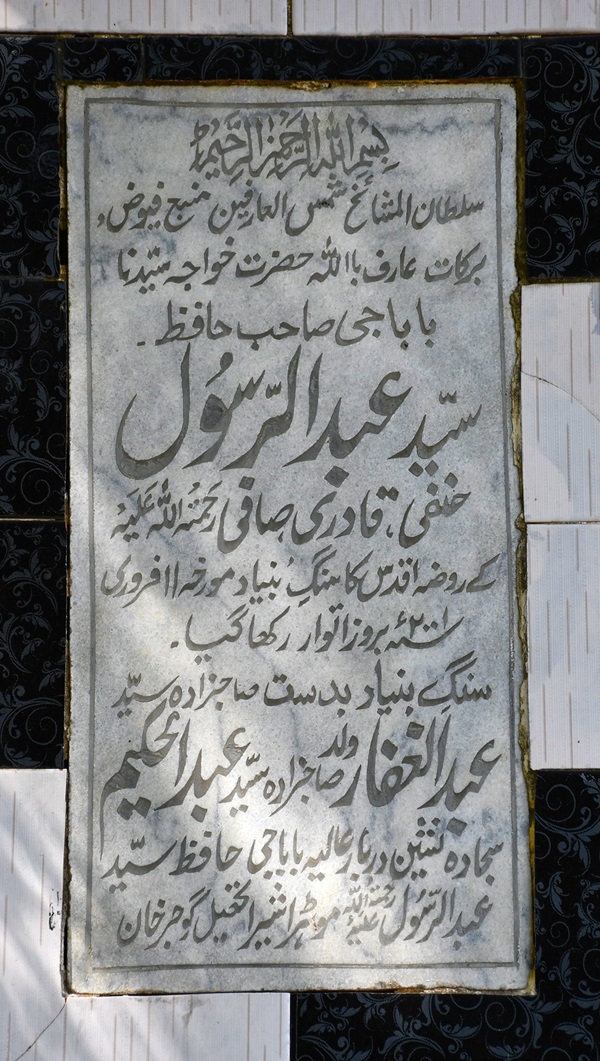Written by: Zulfiqar Ali Kalhoro
Posted on: November 29, 2024 |  | 中文
| 中文
Shrine of Hafiz Syed Muhammad Ayub Shah Qadiri Qalandari at Kuri Jajwal. (Picture credits to Zulfiqar Ali Kalhoro
Gujar Khan, in the Rawalpindi district, is home to numerous shrines found throughout its villages and towns. Kuri Jajwal village near Jand Najjar, located in the Gujar Khan tehsil, is famous for its shrines of Sufi saints. One notable shrine is that of Hafiz Syed Muhammad Ayub Shah Kazmi, who was born in Charsadda in 1693 AD. His father, Syed Shamsuddin Kazmi, was celebrated for his piety in Charsadda. It is believed that Hafiz Syed Muhammad Ayub Shah Kazmi received his early education from his father.
According to Gulishtan-e-Kazmi (2002), an Urdu manuscript by Syed Muhammad Abdul Quddus Pirzada, Hafiz Syed Muhammad Ayub Shah Qadiri Qalandari came from Charsadda to Kuri near Jand Najjar in Gujar Khan in 1720 AD.

Graves of Hafiz Syed Muhammad Ayub Shah and Syed Muhammad Riaz ul Hasan Kazmi, Kuri Jajwal. (Picture credits to Zulfiqar Ali Kalhoro)
I first visited the shrine of Syed Muhammad Ayub Shah on December 8, 2021, and again on November 16, 2024. During my visit, I met Syed Muhammad Abdul Quddus Pirzada, the author of Gulistan-e-Kazmi and the Sajjada Nashin (custodian) of the Hafiz Syed Muhammad Ayub Shah Qadiri Qalandari Darbar. He showed me manuscripts and a page from roznamcha (diary/log book) by Hafiz Syed Muhammad Ayub Shah. That page in Persian from roznamcha provides information about his foundation of khanqah, mosque and rooms for students at Kuri village. It is also written on a page that his forty disciples and brother Syed Biyazuddin also came to Kuri. Later, after staying 15 days in Kuri, his brother Syed Biyazuddin returned to Charsadda to arrange the annual urs of his father Syed Shamsuddin. This page also contains additional information on other things.
Hafiz Syed Muhammad Ayub Shah was a scholar and Sufi who preached in Kuri Jajwal and neighbouring areas. Many people became his followers. He was Qadiri Qalandari Sufi. It is not known from whom he received initiation into Qadiri Qalandari Silsila. One also learns from the roznamcha of Hafiz Syed Muhammad Ayub Shah Qadiri Qalandari about an eminent Qadiri Naushahi sufi saint, Shaikh Muhammad Ji, who was the contemporary of Hafiz Syed Muhammad Ayub Shah. It is stated that Baba Shaikh Muhammad Ji gave two cows for the expenses of madrasa. Moreover, one learns that Ghulam Mir, son of Baba Shaikh Muhammad Ji, started memorizing the Holy Quran in the madrasa of Hafiz Muhammad Ayub Shah. A date is mentioned in a roznamcha (diary), but the year is missing. It is difficult to know in which year Ghulam Mir, son of Baba Shaikh Muhammad Ji, started studying in the madrasa. Hafiz Muhammad Ayub Shah Qadiri Qalandari also noted Baba Shaikh Muhammad Ji's death date in his book of Tawaizat. As per the information in the book of Tawaizat by Hafiz Muhammad Ayub Shah, Baba Shaikh Muhammad Ji died on 14 Rabi-ul Awal, 1173/ 4 November 1759. He also noted the death year of another saint, Baba Syed Kamil Shah from Kuri Jajwal, who died on 27 Ramzan, 1063/ August 20, 1653. The grave of Syed Kamil Shah is located in the main graveyard of Kuri Jajwal village.

Gravestone of Hafiz Syed Muhamamd Ayub Shah Qadiri Qalandari. (Picture credits to Zulfiqar Ali Kalhoro)
Baba Shaikh Muhammad Ji was a deputy of Syed Mir Kalan Badshah who was himself a deputy of Khwaja Hafiz Qaimuddin Barqandaz (d.1765), who was a deputy of Pir Muhammad Sachiar (d.1707). Pir Muhammad Sachiar was a deputy of Haji Muhammad Naushah Ganj Bakhsh Qadiri (d. 1654), the founder of the Naushahiyya branch of Qadiriyya Silsila.
Hafiz Muhammad Ayub Shah Qadiri Qalandari died on 13 March 1792, leaving behind a son named Syed Abdul Khalil Shah Kazmi. According to Syed Abdul Quddus, after the death of Hafiz Syedb Muhammad Ayub Shah, Syed Abdul Khalil Shah Kazmi went to Iraq, where he stayed for three years. Upon his return to Kuri, disciples of Hafiz Syed Muhammad Ayub Shah requested him to settle in Mohra Shera. Upon the plea of his followers, he went with them to preach in Mohra Shera, where he died on 22 Shawal 1228/ 0ctober 17, 1813 and was buried in the main graveyard of the village. He left behind one son named Syed Khan Muhammad Shah Kazmi. He was also known for his piety. He preached in Mohra Shera and neighbouring villages. He died on February 15, 1840, and was buried beside his father. He left behind one son, Hafiz Syed Abdul Rasool Kazmi. Hafiz Syed Abdul Rasool Kazmi became a well-known Qadiri saint in Mohra Shera village. According to Hasan Nawaz Shah (2013:30), the author Gujar Khan Ke Suhrawardi Mashaikh, Hafiz Abdul Rasool Kazmi, was initiated into Qadiriyya Silsila by Shaikh Muhammad Pannah Peshawari. Sain Mahiya, whose shrine is located at Kuri Haider village near Jand Najjar, was also a disciple of Shaikh Muhammad Pannah Peshawari. Both Hafiz Syed Abdul Rasool Qadiri and Sain Mahiya Qadiri were the disciples of the same spiritual master, Shaikh Muhammad Pannah Peshawari.

Foundation plaque of tomb of Hafiz Syed Abdul Rasool at Mohra Shera. (Picture credits to Zulfiqar Ali Kalhoro)
I have also visited the tomb of Hafiz Syed Abdul Rasool Qadiri at Mohra Shera village, which is located about 5 km west of Chak Daulat village in Gujar Khan tehsil. There are two graves in the tomb, which belong to Hafiz Syed Abdul Rasool Qadiri and Syed Mehboob Alam Shah Kazmi, respectively. Hafiz Syed Abdul Rasool Qadiri died on 23 October 1876. On February 11, 2001, a beautiful tomb was constructed over the graves of Hafiz Syed Abdul Rasool Qadiri and Syed Mehboob Shah Kazmi (d.1906). Syed Abdul Ghaffar, the son of Syed Abdul Hakeem and the Sajjada Nashin of Hafiz Syed Abdul Rasool Darbar, built the tomb.
Hafiz Syed Abdul Rasool Qadiri had one son named Syed Faqir Muhammad Shah, who died during his lifetime in 1865 and was buried in the old graveyard of Mohra Shera, where the graves of Syed Khalil Shah Kazmi, his son Syed Khan Muhammad Shah Kazmi are found. Syed Faqir Muhammad Shah had three sons: Syed Muhammad Alam Shah, Syed Mehboob Alam Shah and Syed Said Alam Shah.
Syed Mehboob Alam Shah Kazmi had nine sons, including Syed Shuja ul Mulk Shah Kazmi, Syed Abdul Ghani Shah Kazmi, Syed Saed Khan Mulk Kazmi, Syed Abdul Hayee Shah Kazmi, Syed Abdur Rahman Shah Kazmi, Syed Abdul Khaliq Shah Kazmi, Syed Abdul Wahid Shah Kazmi, Maulana Syed Muhammad Abdul Karim Shah Kazmi and Syed Abdul Hakeem Shah Kazmi.
Kazmi Qadiri saints preached not only in Gujar Khan but also in other districts of Punjab. Maulana Syed Muhammad Abdul Karim (d.1985), whose grave is also located in the graveyard of Hafiz Syed Abdul Rasool Qadiri, was initiated into Naqshbandi Silsila by Khwaja Abdul Ali Mastalvi, son of Khwaja Muhammad Amin (d.1901). The shrine of Khwaja Abdul Ali and his father, Khawaja Muhammad Amin, is located at Mastal Sharif in Islamabad.
Syed Muhammad Riaz ul Hasan built the tomb over the grave of Hafiz Syed Ayub Shah Qadiri Qalandari in 1998. Syed Muahmmad Riaz ul Hasan, son of Syed Abdul Hayee Kazmi, died in 2009. He was buried in the tomb of Hafiz Syed Ayub Shah. He was Risaldar in the Pakistan army and received the prestigious title of Sitara-e-Jurat. He was also Sajjada Nashin of Darbar of Hafiz Syed Ayub Shah Qadiri Qalandari. After he died in 2009, his son Syed Abdul Quddus became the Sajjada Nashin of Hafiz Ayub Shah Qadiri Qalandari Darbar.
The writer is an anthropologist. He has authored 16 books on Pakistan's cultural heritage and anthropology. He tweets @kalhorozulfiqar.
You may also like: